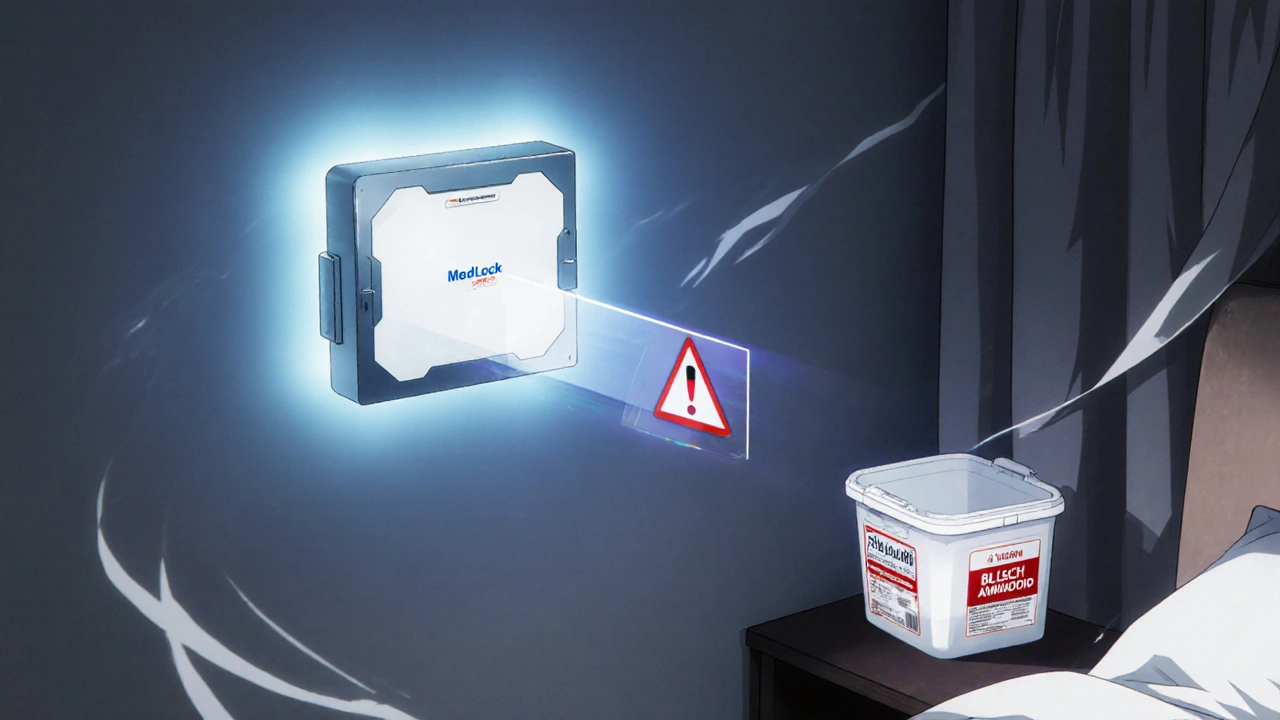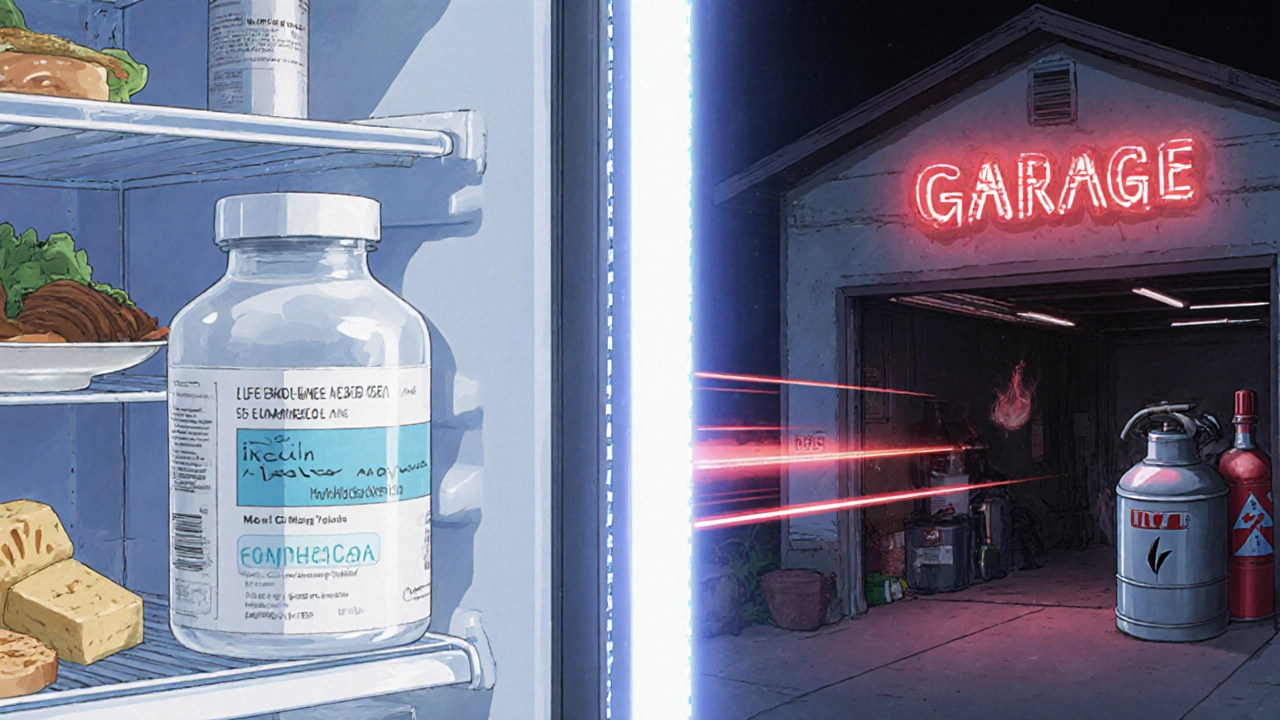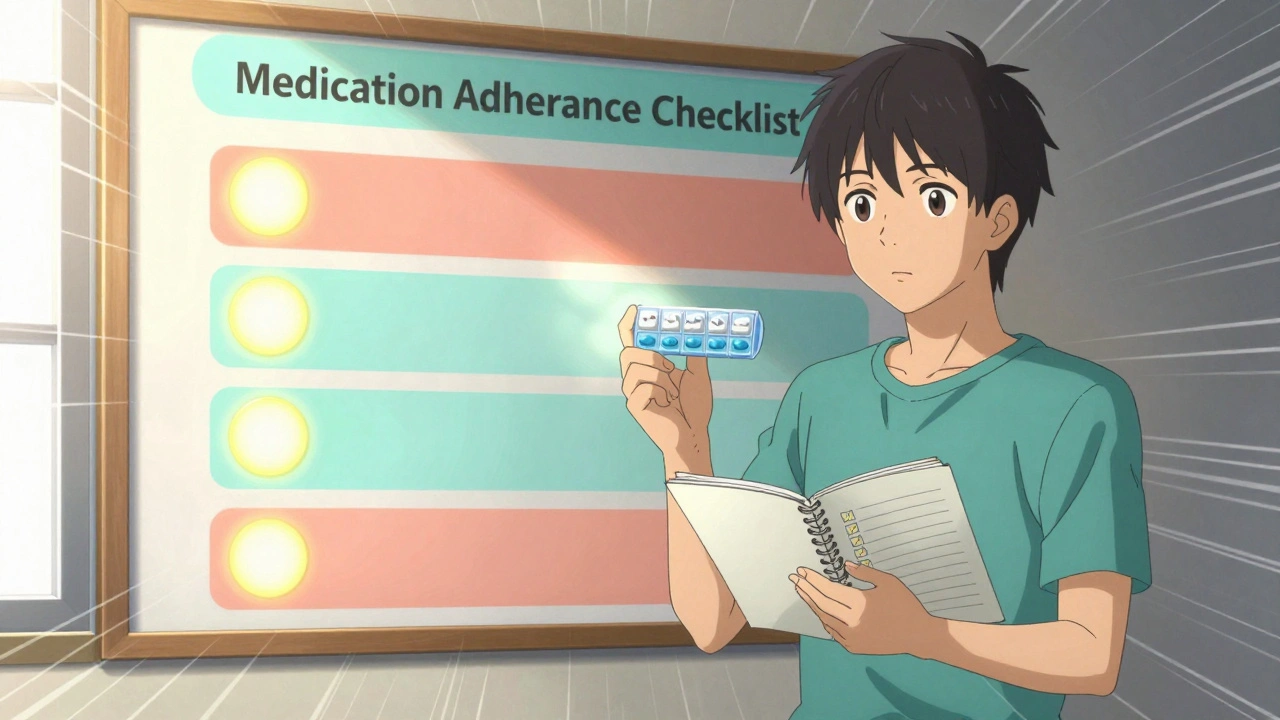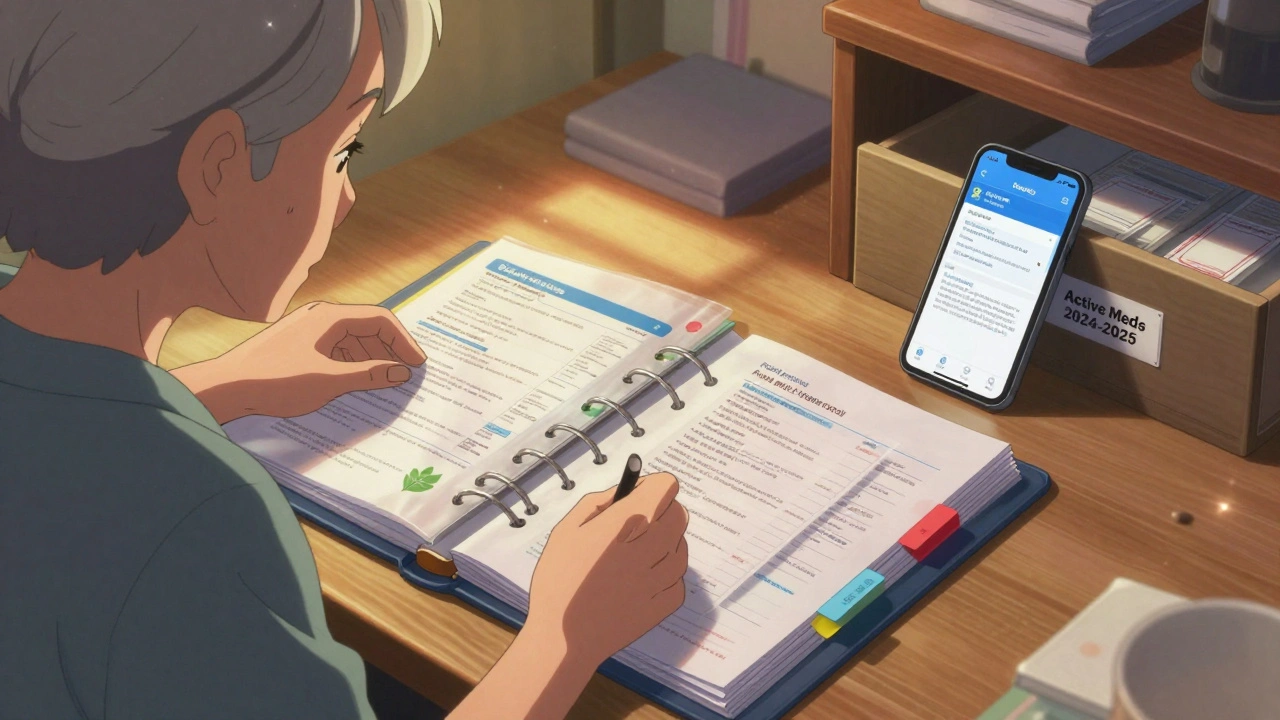How to Separate Household Chemicals from Medication Storage for Safety

Every year, 60,000 children in the U.S. end up in emergency rooms because they accidentally swallowed medication - and in most cases, it wasn’t because they found pills on the counter. It was because the medicine was stored right next to cleaning products, right in the same cabinet. That’s the problem. You don’t need to be a scientist to fix it. You just need to know where to put things - and why.
Why Mixing Medicines and Cleaners Is Dangerous
It’s not just about kids getting into stuff. When medications and household chemicals share the same space, they can ruin each other. Some cleaning products give off fumes - even if you can’t smell them. Those fumes can make pills break down faster. A 2022 study from New York University found that medicines stored within two feet of chemical cleaners lost up to 37% of their strength in just a few months. That means your blood pressure pill, your asthma inhaler, or your child’s antibiotic might not work when you need it most. Then there’s the risk of mixing. If someone grabs a bottle thinking it’s medicine but it’s actually drain cleaner, the results can be deadly. The American Association of Poison Control Centers recorded over 45,000 cases in 2022 where people accidentally took chemicals thinking they were meds - or vice versa. Most of these happened because both were stored in the same bathroom cabinet.Where NOT to Store Medications
The bathroom is the worst place. It’s hot, damp, and full of cleaning sprays. Even if your medicine bottle says “store at room temperature,” that doesn’t mean the bathroom counts. The heat from showers and steam from sinks can make pills crumble or turn sticky. Refrigerators might seem like a good idea - but storing medicine in the fridge door? Big mistake. The temperature there swings by more than 10°F every time you open it. Pharmaceuticals need stable temps between 58°F and 86°F. The center of the fridge (36°F-46°F) is fine for liquid meds - but only if they’re in a sealed container, away from food and chemicals. Kitchen drawers? No. That’s where you keep spray cleaners, bleach bottles, and dish soap. One study found that 38% of households stored pills in kitchen drawers - right next to things that can cause chemical reactions or accidental poisonings. Even the pantry isn’t safe if you keep vinegar, ammonia, or oven cleaner nearby.Where to Store Medications
The best spot is a locked cabinet, high up - at least 60 inches from the floor. That’s above most children’s reach and away from floor-level chemicals. The CDC and Seattle Children’s Hospital both recommend this. Locks aren’t just for kids. They stop confused older adults from grabbing the wrong bottle. A 2023 study showed households using lockable medication boxes (like the MedLock Pro 3000) had 89% fewer accidental poisonings than those using open cabinets. If you don’t have a lockable cabinet, use a small, hard-sided box with a latch - like a tool box or a safe. Put it on a high shelf in a bedroom, hallway, or closet. Make sure it’s dry. Don’t put it near windows where sunlight can hit it. Sunlight degrades some medications, especially insulin and thyroid pills.Where to Store Household Chemicals
Household chemicals - bleach, ammonia, drain cleaner, paint thinner, pesticides - need their own space. They should be stored below eye level, no higher than 54 inches from the floor. Why? Because if they leak or spill, they won’t splash into your eyes. The USC Environmental Health and Safety guidelines say corrosive chemicals must be stored in secondary containers - like plastic bins with raised edges - to catch leaks. Keep them away from heat sources. Don’t store them under the sink if the pipes run hot. Don’t put them near the water heater or furnace. Flammable liquids like gasoline or lighter fluid? Never store them inside the house at all - keep them in a detached shed or garage, in a metal safety can.
Separation Distance Matters
You can’t just put them on opposite sides of the same cabinet. You need space. Experts say you need at least six feet between your medication storage and your chemical storage. The EPA found that 83% of accidental poisonings happened when both were stored within three feet of each other. That’s less than two big steps. In homes with limited space, this is tough. But you can still do it. Put meds on a high shelf in the bedroom. Put cleaners under the kitchen sink - but only if you have a separate cabinet, not a shared one. Use clear bins to group chemicals by type: one bin for acids (vinegar, toilet bowl cleaner), one for bases (ammonia, baking soda), and one for solvents (rubbing alcohol, nail polish remover). Never mix acids and bases - even in storage - because they can react and release toxic gas.Refrigerator Rules
If you need to refrigerate medicine - like insulin, some liquid antibiotics, or eye drops - put it in a sealed plastic container inside the fridge. Don’t put it on the door. Put it in the back, where the temperature is most stable. And here’s the key: never store medicine next to food. The FDA says this increases the risk of confusion. Use a small, labeled container - maybe a plastic box with “MEDS ONLY” written on it. Keep that box away from any cleaning supplies you might store in the fridge, like hydrogen peroxide (used for disinfecting) or bleach-based cleaners (sometimes kept for mold removal). Flammable chemicals? Never in the fridge. Ever. Even if it’s “just a little.” The spark from the compressor can ignite vapors. That’s not a myth - it’s happened.Label Everything - Even the Containers
Original bottles are great. But if you’ve transferred pills to a pill organizer, write the name, dose, and expiration date on the container. Don’t rely on memory. The CDC says households that kept meds in original containers with clear labels reduced confusion incidents by 67%. For chemicals, keep the original labels. If they’re faded, rewrite them with a permanent marker. Use color-coded bins: red for hazardous, yellow for cleaners, green for non-toxic. A 2023 study from the InfantRisk Center found color-coding cut down accidental mix-ups by 62%.
What About Smart Storage?
New tech is helping. Devices like the SafeMed Home System monitor temperature and humidity inside storage boxes. If the environment gets too hot or damp, it sends a warning to your phone. In pilot programs, these systems cut medication degradation by 53% and chemical reaction risks by 61%. They’re not cheap - but if you have multiple family members on daily meds, they’re worth it. Even simpler: RFID-tagged containers are being tested. They alert you if a cleaning product comes within three feet of a medicine box. The National Institute of Standards and Technology found these systems detect dangerous proximity with 98% accuracy. They’re not widely available yet - but they’re coming.Common Mistakes (And How to Avoid Them)
- Mistake: Storing meds in the bathroom cabinet. Fix: Move them to a high bedroom shelf or locked box.
- Mistake: Keeping cleaners under the sink with meds. Fix: Use a separate cabinet or closet. If you must share, put chemicals on the bottom shelf, meds on top - but still six feet apart.
- Mistake: Using the fridge door for medicine. Fix: Store meds in the back, in a sealed container.
- Mistake: Not labeling pill organizers. Fix: Write everything down. Use a label maker if you have one.
- Mistake: Thinking “I’ll just keep it in the drawer.” Fix: Drawers are for socks, not poisons.
What to Do With Old or Expired Items
Don’t flush pills. Don’t toss them in the trash with chemicals. Use a drug take-back program. Most pharmacies, hospitals, and police stations have drop boxes. In Australia, you can return unwanted meds to any pharmacy - they’ll dispose of them safely. For chemicals, check your local council’s hazardous waste collection day. Brisbane has monthly drop-offs at transfer stations. Never mix chemicals in one bottle. Keep them separate - even in disposal.Final Checklist
- Store all medications in a locked box, at least 60 inches high.
- Keep household chemicals in a separate cabinet, below 54 inches.
- Maintain at least six feet of distance between the two storage areas.
- Use sealed, labeled containers - no exceptions.
- Refrigerated meds? Use a sealed container in the back of the fridge, away from food and cleaners.
- Never store flammable chemicals indoors.
- Dispose of old meds and chemicals through official take-back programs.
You don’t need a fancy system. You just need to be clear. Medicines are for healing. Chemicals are for cleaning. Keep them apart - and you’ll protect your family, your health, and your peace of mind.
Can I store medications and cleaning products in the same cabinet if I keep them on different shelves?
No. Even on different shelves, fumes from cleaners can degrade medications, and the risk of accidental mixing is too high. Experts recommend at least six feet of separation between storage areas. If you only have one cabinet, choose one purpose - either meds or chemicals - and store the other elsewhere.
Is it safe to store medicine in the kitchen?
Only if the kitchen has a dedicated, locked cabinet that’s completely separate from cleaning supplies. Most kitchens have sprays, bleach, and detergents under the sink - which makes it a high-risk zone. If you must use the kitchen, keep meds in a locked box on a high shelf, far from the sink and cabinets with cleaners.
Why shouldn’t I store medications in the bathroom?
Bathrooms are humid and hot, which can break down pills and liquids. They also usually contain cleaning products - increasing the risk of accidental poisoning. Studies show that 70% of child poisoning cases happen when meds are stored in bathroom cabinets alongside cleaners. Move them to a dry, cool, locked location instead.
What’s the best way to store liquid medications in the fridge?
Put them in a sealed, clearly labeled plastic container and store it in the back of the fridge - not the door. Keep it away from food and any cleaning products you might store there, like hydrogen peroxide. Temperature should stay between 36°F and 46°F. Avoid placing it near the freezer compartment.
Can I use a lockbox for both medications and chemicals?
No. Lockboxes are designed for one purpose: keeping medications away from children and pets. Storing chemicals in the same box risks contamination, chemical reactions, or fumes damaging the meds. Always use separate containers - even if they’re both locked.
How often should I check my medication and chemical storage?
Check every three months. Look for expired meds, faded labels, leaking bottles, or strange smells. Replace damaged containers immediately. If your medicine looks discolored, cracked, or smells odd - throw it out and get a new one. Same for chemicals: if a bottle is bulging or corroded, dispose of it safely.
Are there any free resources to help me dispose of old meds or chemicals?
Yes. In Australia, all pharmacies accept unwanted medications for safe disposal. For household chemicals, check your local council’s website - Brisbane and most cities offer free hazardous waste collection days. You can also call your local waste management service - they’ll tell you where and when to drop off.






Comments
Kelsey Robertson
November 16, 2025 AT 19:27Let me just say this: if you’re storing meds next to bleach, you’re not just irresponsible-you’re a walking public health hazard. I’ve seen it. I’ve lived it. Your grandma’s blood pressure pills? They’re probably dust by now. And you wonder why your insurance premiums are through the roof? It’s because people like you treat medicine like a pantry item. Fix it. Or don’t. But don’t pretend you’re doing your family any favors.
Elia DOnald Maluleke
November 16, 2025 AT 20:50One must contemplate the metaphysical implications of pharmaceutical storage: are we not, in our negligence, committing a quiet violence against the very substances meant to sustain life? The cabinet, that humble vessel of domestic order, becomes a battlefield of entropy-where alkaline fumes conspire with moisture to unravel the delicate chemistry of salvation. To store medicine beside cleanser is not merely poor housekeeping-it is an ontological failure.
satya pradeep
November 18, 2025 AT 02:01Bro this is 100% true. I used to keep my insulin next to the drain cleaner in the bathroom-dumb move. One day my cousin grabbed the wrong bottle after a party and almost went blind. Now I keep meds in a locked box on top of my wardrobe. Simple. Cheap. Works. Also-stop using the fridge door. That thing is a temperature rollercoaster. Chill out. Literally.
Prem Hungry
November 18, 2025 AT 12:15Allow me to offer a structured approach to your household safety protocol. First, establish a dedicated pharmaceutical repository, elevated and secured. Second, designate a chemically inert zone, grounded and ventilated. Third, implement visual segregation via color-coded containers, as per ISO 3864-1 guidelines. Fourth, conduct quarterly audits. Fifth, educate all household members. Sixth, document compliance. Seventh, repeat. Safety is not an event-it is a discipline.
Leslie Douglas-Churchwell
November 19, 2025 AT 21:15Okay but have you heard about the CIA’s secret program to make people forget where they store their meds? 😳 They’re using 5G microwave resonance to scramble memory in bathroom cabinets. That’s why everyone’s mixing bleach with Tylenol. Also, your ‘locked box’? Probably bugged. Use a Faraday cage. Or better yet-live in a yurt. 🌿⚡ #MindControl #MedSafety
shubham seth
November 20, 2025 AT 09:10Y’all are acting like this is rocket science. It ain’t. It’s basic survival. If you’re dumb enough to keep aspirin next to Drano, you probably also think ‘organic’ means ‘free from common sense.’ Your kid’s gonna end up on TikTok with a stomach pump. And you’ll blame the government. Spoiler: it’s your fault. Fix it. Or die quietly.
Kathryn Ware
November 22, 2025 AT 01:24OMG I love this post so much!! 🙌 I literally just reorganized my whole house last weekend because of this. I got those cute labeled bins from Target (the ones with the little chalkboard labels??) and now my meds are in a locked box on the top shelf of my bedroom closet, and my cleaners are in a plastic tub under the kitchen sink with a rubber mat underneath-just in case. I even made a little chart for my kids! 📋💖 It feels so good to be safe and organized. Also, I bought a SafeMed Home System-worth every penny. My anxiety dropped 80%. You guys, safety is self-love. 💕
kora ortiz
November 23, 2025 AT 07:47Do it. Now. No excuses. Your family’s life depends on it. Locked box. High shelf. Six feet. No exceptions. Done.
Jeremy Hernandez
November 24, 2025 AT 11:31Lmao why are we even talking about this? It’s 2025. You’re telling me people still keep pills in the bathroom? Bro. I don’t even have a bathroom cabinet. I have a lockbox bolted to the wall next to my dumbbells. If you’re still using a medicine cabinet, you’re one bad shower away from a coroner’s report. Just move it. Stop overthinking it.
Tarryne Rolle
November 24, 2025 AT 12:42It’s ironic, isn’t it? We’re told to be mindful of toxins, yet we willingly house them in the same space as our lifelines. We fear the unknown, yet we normalize the predictable. The real tragedy isn’t the accidental ingestion-it’s the collective denial that this is even a problem. We’ve outsourced safety to convenience. And now, we’re surprised when the system fails.
Kyle Swatt
November 26, 2025 AT 06:21I used to think this was overkill-until my neighbor’s 3-year-old swallowed a bottle of Orajel thinking it was juice. The kid’s fine now. But the smell of that chemical? I still dream about it. Don’t wait for a nightmare to wake you up. Move the meds. Separate the crap. Label everything. And for the love of god, don’t let your kids see you reach for the drain cleaner like it’s a snack.
saurabh lamba
November 27, 2025 AT 09:28Why so complicated? Just put everything in the garage. Done. Also why are we still using paper labels? Use QR codes. Scan and know what it is. Simple. Why are we still alive in 2025 doing this manually? 😴
Kiran Mandavkar
November 28, 2025 AT 04:13Let’s be real: if you’re still storing meds in a cabinet that isn’t biometrically locked and climate-controlled, you’re not just careless-you’re culturally bankrupt. The fact that this even needs to be explained means we’ve regressed as a species. I have a 3D-printed, nitrogen-sealed, AI-monitored dispensary. You? You’re still using a plastic drawer. Sad.
Eric Healy
November 29, 2025 AT 15:41Yeah but what about the people who live in apartments with no extra shelves? Or in places where the only dry spot is the bathroom? You’re acting like everyone has a closet to spare. This advice is for rich people with 3-bedroom houses. The rest of us are just trying not to die in a 400sqft studio with a sink and a fridge. 🤷♂️